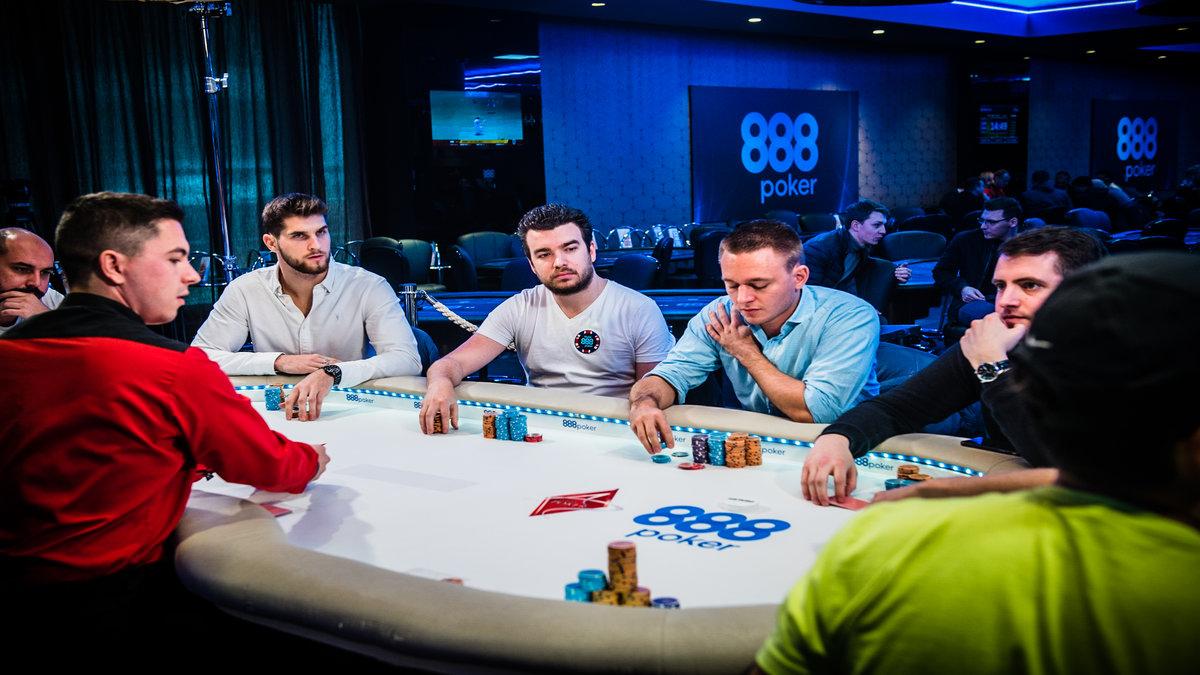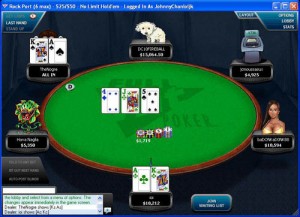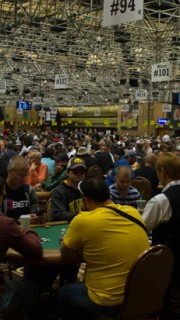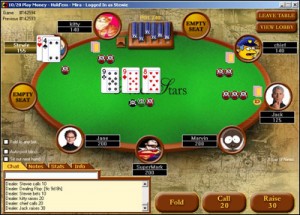Early Poker Tournament Strategy
- Early Poker Tournament Strategy Payout
- Early Poker Tournament Strategy Against
- Early Poker Tournament Strategy Rules
There’s a common misconception that the early stages of a no-limit hold‘em tournament are unimportant. The argument goes that the blinds are too small to be worth stealing, and consequently any pot you win or lose is generally too small to make much difference to your stack. After all, a medium-sized pot in level one will amount to nothing more than a big blind or two a few levels later.
In this article we’ll cover the tight strategy for the early stages of tournament play from a pro-con perspective. It’s up to you to determine what approach fits best into your game, but hopefully the below will give you a starting point for analyzing whether or not tight really is right for you. MTT tournament strategy at an early stage implies a non-standard decision-making in order to get the maximum value. If there are a lot of aggressive players at your tables, then you should use a counter-strategy against them, thereby giving them an opportunity to grant you their chips. Conclusion - Single table tournament strategy wrap-up. Now that you've finished this article, you have a better understanding of the general direction you should be taking in the single table tournament games on Party Poker. Here is a recap of the main strategy pointers: Early Levels: Play tight, solid poker; Only bet when you have a hand. Early in Tournaments. The WSOP Is the Most Famous Poker Tournament in the World. It’s best to play a tighter style in the early stages of these events. A lot of weak players are going to be in the field. Many of these players are going to be on draws.
This may be true for a certain type of tournament specialist who is an expert at stealing and restealing preflop but is inexperienced at postflop play. In truth, though, a skilled player’s potential edge is highest when stacks are deepest. This is because he has more tools at his disposal and there is room for his opponents to make extremely expensive errors.
This article will introduce you to some of the tools that great players use to accumulate chips during the early stages of a tournament and help you to avoid some of common misunderstandings that can lead to big mistakes when playing deep.
Position, Position, Position
It’s level one of a $10,000 main event. Everyone has roughly 300 times the big blind in his stack. There are several professionals at the table, and while some players appear weaker than others, none seem likely to make huge mistakes.
At such a table, I’m happier to be dealt a suited J-10 on my button than a pair of aces in first position. Granted, with the aces, I’m guaranteed either to steal the blinds or get money into the pot as a favorite on at least one street. Preflop is almost always the smallest betting round, though, and it’s likely that I’ll have to play out of position postflop, possibly against multiple opponents. That means that their decisions will generally be better than mine on the next three streets, when the bets are larger.
This isn’t a matter of J-10 suited being a better deep-stacked hand than aces. I’d still rather have the aces if I get the button either way, and that’s true no matter how deep we get (within reason – it’s possible that at some insanely huge stack depth the fact that a big suited connector will make more nut-straight flushes than A-A becomes overwhelmingly important). The point is that I’d rather have a good hand and the best position than the best hand and poor position.
There’s a point, probably when stacks are a little less than 100 times the big blind, when this changes. At that point, I’d rather have the aces in early position, because the preflop action becomes more significant. There’s less room for opponents with position to outplay me postflop, so my preflop edge counts for more.
Implied Odds Matter More Than Immediate Odds
At the same table, if I were in the big blind with an offsuit K-8, facing a minimum raise from a good player on the button, I would fold. This is true even if I knew he were opening any two cards, even though I know I’d be a 56 percent favorite against that range and getting 2.5-to-1 pot odds.
At that moment, there are 250 chips in the pot and 30,000 in my stack, so I need to be a lot more concerned about protecting the latter than the former. Playing out of position against a good player with a hand that will very rarely make anything stronger than a single pair with an uninspiring kicker is a recipe for tough postflop decisions. I don’t want to end up putting thousands of chips at risk to protect my equity share in a pot of 250.
Those chips would be at risk because I’ll virtually never make a strong hand with the K-8. On almost any board, the best I’ll be able to do is check, make a guess about my opponent’s bluffing frequency, and either call or fold. Good players will value bet well with almost any hand better than mine and bluff well when I have the best hand with king-high or third pair.
Against a weak player who wouldn’t make such good use of his position, I would call here. My postflop decisions wouldn’t be so difficult against such a player, making it easier for me to show my hand down when it’s a winner and get away cheaply when it isn’t.
Likewise, if stacks were much shorter, say 30 or 40 times the big blind, I’d be more inclined to defend against a good player. The potential downside of difficult decisions on lower streets would be much lower, and consequently I could give more priority to defending my equity in the current, small pot.
Shoot for Hands That Can Win Big Pots
In a no-limit hold‘em game, your whole stack could be at risk at any time. Tough opponents will put you to the test with bets and raises that threaten your stack, and if you consistently hold cards that can’t take that kind of heat, you’re going to face impossible decisions.
This is especially true when you’re out of position, with less control over the size of the pot. With the advantage of position, you can get away with making marginal hands postflop, because you’ll have more information to figure out whether you can call, value bet, get to showdown, etcetera. When out of position against a tough opponent, you’d like to avoid murky situations, and that starts with not playing cards preflop that rarely make hands with which you’d want to play a big pot.
Depending on the texture of a given board, straights, flushes, and full houses will generally be the sorts of hands you’ll want to hold when putting two or three hundred big blinds into the pot. Of course, those aren’t easy to make, but they are what you want to shoot for. Even strong hands such as overpairs and top pair with a good kicker are more like consolation prizes. Although an offsuit K-J will amount to the same thing as its suited counterpart on most rivers, the suited hand is much better when you are deep because of the possibility of making a two-card flush. Even a draw to a nut or near-nut hand can be more desirable than a marginal pair with little hope of improving.
This is part of the reason to fold K-8 offsuit to the button’s raise, but it should affect most of your preflop decisions, particularly when you’re likely to end up playing out of position. At a tough, nine-handed table full of deep-stacked players, A-J offsuit is an open fold from first position, but J-T suited is a raise. It’s better to flop an open-ended straight draw than top pair with no redraw when you’re out of position against one or more players who don’t give up easily. And if you do happen to flop top pair with the J-T, it won’t be worth that much less than if you’d done it with the A-J.
Bluff
If your strategy for the early levels of a tournament is to play conservatively and wait for either good cards or blinds that are worth stealing, then you are easy to play against. You will never give your opponents difficult decisions. This strategy will work reasonably well against players who don’t have the wherewithal to get out of your way on the rare occasion that you show interest in the pot, but the only way you’ll ever take chips away from a good player will be with a suckout or a massive cooler.
You can make yourself a much tougher opponent simply by playing your best draws aggressively, not just when your opponent could have nothing, but when it seems clear that he has a marginal made hand. If he’s just checking and calling from out of position, keep firing big bets with both your good top pair hands and your eight- and nine-out draws. This puts him in the impossibly difficult spot I’ve been trying to teach you to avoid.
Of course, in order to have eight and nine-out draws to semibluff with, you have to raise preflop with the sorts of hands that create those draws, namely suited connectors and suited aces. This brings us back to the point about shooting for hands that can win big pots. With 30 big blinds, your goal is to make a good pair and go with it. With 300, you’re much better off making a nut draw if you don’t make the nuts, and you need to adapt your preflop strategy accordingly.
Conclusion
Of course this only scratches the surface, and there are quite a few things that the best players do successfully when very deep stacked. These general principles, however, should you help you quickly conceptualize the difference between 30 big blind poker and 300 big blind poker and avoid the toughest spots altogether. ♠
Andrew Brokos is a professional poker player, writer and coach. He blogs about poker strategy on ThinkingPoker.net and is co-host of the Thinking Poker Podcast. Andrew is also interested in education reform and founded an after-school debate program for urban youth.
Multi-table poker tournaments (also known as MTT's for short) of all field sizes and buy-in levels can be found online 24 hours a day.
This article will cover basic multi-table tournament strategy at the various stages that a tournament will go through before the lucrative final table.
MTT prize pool structure.
We will start by looking at the key factor of how the prize pool in a multi-table online poker tournament is distributed – and the big influence this needs to have on your strategy in order to maximize your poker winnings over time. Next we go through the early, middle (including the bubble) and later stages of a poker tournament showing what factors influence your strategy at each point.
Tournament prize distribution is very ‘top heavy’. The players who reach the final table will split up to half of the total prizes between them – while those who make it into the first paying spots only will often win less than twice their initial buy-in. Even at the final table the top 3 paying places will give a disproportionately larger payout than the other places.

This has a large effect on tournament strategy for those players who are looking to maximize their long-term profits. Aggressive, positive play is rewarded at all stages of the tournament - by a shot at reaching the final table. Passive play during the later stages may enable you to sneak into the money positions – however this will not make up for just a few final table appearances when adding up profits at the end of the month or year.
Early stage tournament strategy.
In the very early stages of a poker tournament the game plays in a similar way to a cash game table. This is because the stack sizes are many times the size of the blinds, allowing betting on the flop, turn and river for many hands. ‘Deep Stacked’ play involves its own adjustments including favoring hands which can make hidden ‘monsters’ such as small pairs and suited connectors. Hands that are easily dominated such as Ace-Ten and King-Jack should generally be avoided at this stage.

Your strategy objective in the first few blind levels should be to accumulate chips from the weaker opponents who will still be in the tournament at this stage. At the same time you should avoid big ‘gambles’ for all of your chips if you feel that your skill advantage will have time to show over a larger number of small pots.

One saying for the early stages of multi-table tournaments is that ‘you need to take the chips from the weak players before someone else does’ – after all they will be harder to take from a stronger opponent later down the line.
Transitioning from early to late stages.
As the blinds and antes get higher when compared to the average stacks your tournament strategy needs to adjust to new conditions. Since you must invest more chips to see a flop the value of the speculative hands played in the early stages goes down.
High cards however go up in value when you are the first to enter the pot. Since calling a raise in the middle stages requires investing a large proportion of your stack this should be avoided where possible. Your opponents are often in the same situation – meaning that you’re raising requirements can be ‘lighter’ than before, especially from late position.
Playing on the bubble.
The bubble is the stage of the tournament where just a few players need to be eliminated in order to reach the money paying places. At this stage the single most important factor affecting your strategy are stack sizes – both your own and those of your opponents.
Having a large stack at the bubble will allow you to pick up many pots uncontested – as players will be less likely to fight with a big stack when they risk busting out before the money. Other big stacks and very short stacks should be avoided here, as they are more likely to call you.
If you have a medium stack at the bubble then you can use the knowledge that bigger stacks are likely to steal pots to your advantage. If you are dealt a reasonably strong hand and expect the big stack to be ‘raising light’ you can have a positive expectation situation for a re-raise. Sure you will get unlucky and bust out sometimes – but your strategy for the whole tournament is to reach the final table and doubling up could give you a chance to do so, more than making up for losing the small ‘in the money’ payout.
After the bubble ‘bursts’ players will often loosen up considerably in an effort to accumulate enough chips to reach the final table. At this stage you need to choose your spots carefully. As with all forms of poker it is better to be the raiser rather than the caller.
MTT final table strategy.
The final table brings in yet another factor into your poker strategy thinking. Stack sizes are still very important, but now the payout structure – and your opponent’s strategy in relation to this come to the fore.
Early Poker Tournament Strategy Payout
The presence of a very small stack is a good example of how this affects the dynamic of the final table. Medium stacks will see that one player is just 1 big blind away from busting and will tighten up to avoid going out before this player. This can lead to some great opportunities to pick up chips without too much risk.
Aggressive and positive poker are again the key elements to success at this stage of the poker tournament. The top three places will pay proportionately more than the rest – aim high by picking fights with those opponents who look like they would like to move up in the money. Big stacks and small stacks should again be avoided, the medium stacks are much more likely to fold to pressure at this stage.


Early Poker Tournament Strategy Against
MTT strategy evaluation.
In summary, tournament strategy involves adjusting to the various stages which a poker tournament will go through. At the same time your goal in every tournament should be to reach the final table. Busting on the bubble never feels good – however if for each time you bubble you reach another final table then your long-term profits will be better than that of opponents who tighten up in order to make the money.
Go back to the awesome Texas Hold'em Strategy.
Early Poker Tournament Strategy Rules
Comments